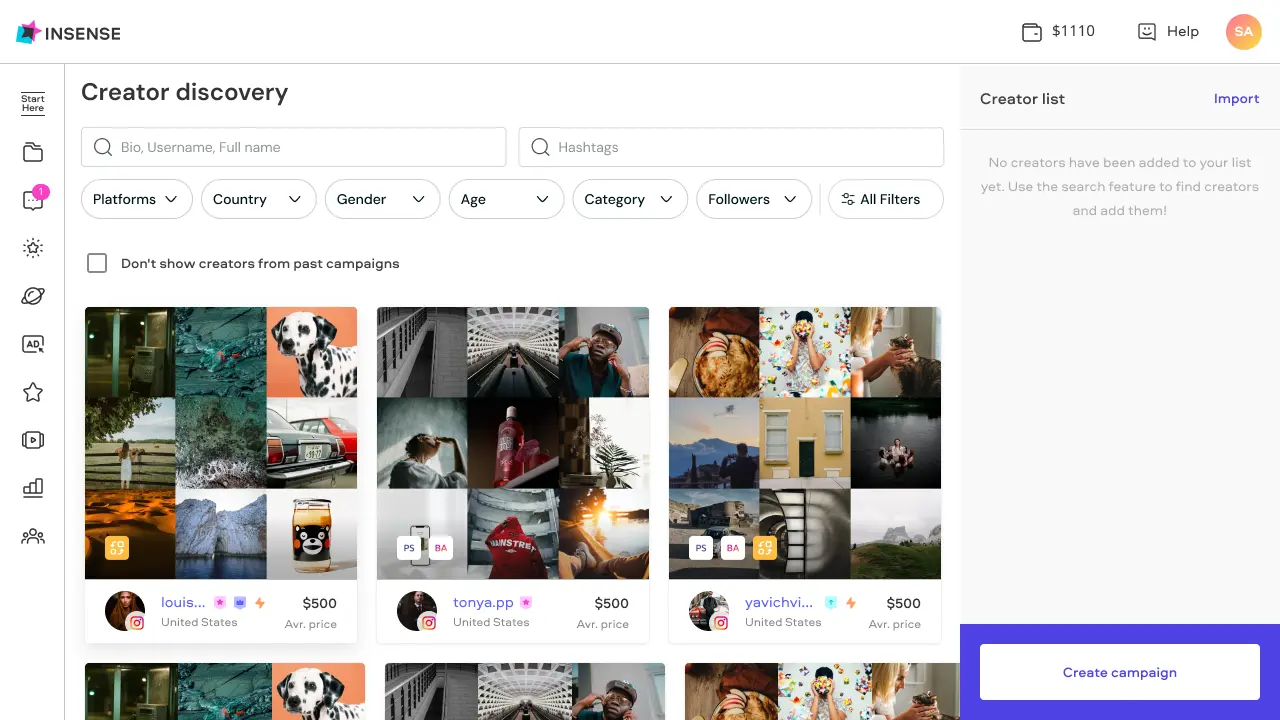Influencer affiliate marketing pays creators a commission for conversions they drive using trackable links or codes.
It blends influencer reach with affiliate attribution so you can scale partnerships, cap risk, and see what actually sells.
Here’s what we’re going to cover in this blog post:
- Definition of influencer affiliate marketing
- Benefits of working with influencer affiliates
- Tips for finding the best influencer affiliates
Let’s get right into it.
What is Influencer Affiliate Marketing?
Influencer affiliate marketing is an influencer marketing strategy which involves a partnership between an affiliate influencer and a brand.
An affiliate partner is someone who collaborates with a business to sell and promote products and services in exchange for a commission.

For instance, if you own an e-commerce store, you can create unique discount codes, coupons, or promo codes and distribute them to the right influencers.
These social media influencers will create and post promotional content about your brand and products, referring their followers to your online store and offering them a unique discount code to make a purchase.
For every purchase made with an influencer’s code, the influencer gets a commission.
Long story short, influencer affiliate marketing is a win-win marketing strategy for both the influencer and the business owner.
You get more sales, higher engagement and conversion rates, brand awareness, and recommendations, while the influencer gets a commission for each sale.
The commission structure is usually calculated according to the number of purchases made with an influencer’s trackable link, which is often their unique promo code.
Affiliate vs Influencer vs Ambassador
Influencer marketing: pays for content or reach. Results vary by creative and audience quality.
Affiliate marketing: pays for results. Commission on sales or leads.
Ambassador programs: long-term creators who do both. They earn commission and may get retainers or product.
How Influencer Affiliate Marketing Works
- Offer: set a commission on sales or qualified actions.
- Track: give each creator a unique link or code.
- Promote: creators post across short video, stories, Lives, blogs, and email.
- Attribute: conversions tie back to the creator via link, code, or platform checkout.
3 Benefits of Working with Influencer Affiliates
The benefits of working with influencer affiliates extend beyond just an increase in new customers, brand exposure, lead generation, or website traffic.
It’s a dynamic process that can help you build engaging social media campaigns that can do all the following:
- Campaigns that help build brand credibility and trust
These influencers, irrespective of their number of followers, have better connections with their followers, and can influence the perception of their followers about a brand.
If they endorse your brand, their followers would take their word for it and see your brand as credible.
Affiliate partnerships help you scale content that sells and pay for results. You control the offer and track what moves product.
- Engaging social media campaigns
People have become more interested in high-quality entertaining, engaging, and interactive content.
And working with an influencer affiliate marketer can help you achieve this.
Some examples of these type of engaging influencer content include:
- Unboxing videos: these can be Youtube videos or social media videos
- Giveaway contests
- Encouraging user-generated content
- Question polls
- Get-ready-with-me videos
- A day-in-my-life videos
- How-to guides and blog posts
- Increased social media following
Brand exposure is crucial to increase the number of followers on your page.
People won’t follow you if they don’t see you.
And more importantly, people cannot visit your store if they do not know it exists.
This is why influencers come into play!
Overall, when you gain new followers, you increase your chances of turning leads into actual customers.
But all of these benefits are only possible when you use the right affiliate influencers.
Learn how in the section that follows.
Top Tips to Find the Best Influencer Affiliates
There is a sea of influencers in the market, but finding the right ones can be a bit tricky.
In this section we’ll discuss steps and tips to help you find influencer affiliates and increase your chances of building a successful affiliate program.
- Define your campaign goal and demographics
The end goal of every affiliate marketer is to make sales and boost revenue.
However, you also need to set certain goals to help filter your influencer search.
Define the objective, audience, and metric: sales or signups; who the buyer is; and how you’ll count success.
- Are you looking for influencers within a specific niche?
- Do you want to drive sales or do you have other goals, like increasing follower count or brand awareness?
- What metrics would you use to measure the success of the campaign?
- Who is your target demographic?
Another great question that can help you define your campaign goal is: What type of affiliate marketing would you like to do?
There are basically 3 types of affiliate marketing:
Unattached: No personal use of the product. Broad reach. Lowest trust.
Related: Same niche as your product. Higher relevance.
Involved: Creator uses the product. Highest trust. Best for reviews and how-tos.
- Look for influencers that resonate with your target audience
Setting your campaign goals includes knowing who your target audience is.
Do you want to sell your product to Gen-Zers or millennials?
Do you know their interests?
Do they follow the influencers you want to work with?
These are important questions you need to consider in your search for the best influencers.
Ensure that the influencers you choose are those whose content formats and niches resonate with your target audience.
A trick to finding them would be to use hashtags.
If you are a fashion brand, searching for hashtags such as #sponsored #ad #fashion #branding on social media platforms will bring you to influencers who have posted industry-related content such as this.
Scan the last 90 days of posts. Favor creators with conversions or repeat buyer comments in your niche.
- Be clear when communicating your vision
The best way to clearly communicate your vision is to write a detailed creative brief.
A creative brief is an overall description of your campaign. It includes your goals, deliverables, and distribution plan.
It basically gives the affiliate influencer an overview of your:
- Expectations for the affiliate
- Brand voice and tone
- Brand guidelines
- Competitors
- Content schedule
- Chosen content formats
These are important points that would give the affiliate a better understanding of your campaign.
Give a one-page brief with goals, claims, dos and don’ts, disclosure wording, and required links and codes.
If you don’t know exactly how to create a detailed brief, you can leverage influencer marketing platforms like Insense’s creative brief feature to brief creators effortlessly.
This powerful tool contains:
- Ready-to-use options
- Interactive features
- Intuitive briefing edits
Plus, you can easily customize the brief to include your content format, reference contents, and content type.

- Consider working with nano and micro-influencers
Nano and micro creators convert well in focused niches.
They publish quickly, test hooks, and adapt formats. Shorten the loop between product arrival and posting.
Micro and nano influencers are perceived to be more credible and trustworthy than macro and mega influencers.
A reason for this is due to their small following.
People feel they can easily relate to them because they are ordinary people with an average amount of followers.
Their audience believe that because they aren’t A-list celebrities, or because they aren’t so famous yet, their recommendations and content are more truthful and genuine.
Therefore, working with these influencers would build trust and credibility amongst their audiences.
To find these influencers, consider using Insense’s creator marketplace.

This marketplace provides you with a list of influencers from all social media platforms such as LinkedIn, Instagram, TikTok, Facebook, Snapchat, and so on.
The tool allows you to:
- Use search filters
- View the performance and rating of the content creators and affiliate influencers
- Find content creators and influencers that align with your target audience
- Invite affiliates to collaborate with your platform
- Personalize your outreach message
This is important because it will help you establish a better relationship with influencers.
Personalize every message. Reference a recent post, offer the product, and state the commission clearly.
Some ideas to improve brand messages are:
- Including the influencer’s name in the subject line to grab their attention. A quick, “Hello Julie”, at the start of the conversation works wonders
- Writing helpful content to give context
- Keeping it short and straight to the point
- Showing them that you’re familiar with their work
- Inviting them to a virtual event
These tips will help show the affiliates that you really explored their work before reaching out to them.
- Customize your affiliate rate
Keep in mind that different influencers have different rates.
As such, brands may need to consider offering different professional rates to increase their chances of working with these influences.
Your commission rates can be customized depending on factors such as: the type of influencer you want to work with and their reach, expected profit margin, present competitive analysis, and bonuses and incentives, among others.
Author’s Tip: Consider your customer lifetime value (CLV) when setting your customized affiliate rate. A CLV is a metric that shows the total net profit you expect to generate from a customer throughout their relationship with you. Putting this into consideration will help you set a reasonable commission without you running on losses.
- Networks
You might choose to join an affiliate marketing network as an addition to using a creator marketplace like Insense.
Choose how you run the program:
Affiliate networks (Impact, CJ, Rakuten, ShareASale) — standard tracking, large partner bases, built-in payouts.
Creator marketplaces (Insense, TikTok Shop affiliates, Amazon Influencer, LTK/ShopMy) — social commerce paths and shoppable media.
Direct program (your site + app) — full control over terms, codes, and landing pages.
Pick one to start. Expand when you need more partners or new channels.
- Work with multiple affiliates to diversify your program
To maximize your reach and diversify your program, you can work with various influencer affiliates.
Onboard a small group first. Keep the partners who hit EPC and conversion targets. Replace the rest.
How Tracking Works Now
Use unique links with UTMs and deep links. Pair links with promo codes for stories and short video. Add server-to-server or platform checkout tracking where you can. Sync codes with your store or app so sales always credit the right creator.
Now Over to You
You’ve got the essentials to launch and scale an affiliate creator program.
The steps are simple: find influencers that align with your campaign objectives, create a unique link for them, and negotiate a reasonable payout.
Remember that with affiliate influencer marketing, you not only attract new demographics through engaging influencer posts, you also drive sales and traffic to your online store.
Having trouble finding the right influencers to work with? Try Insense today!
Frequently Asked Questions (FAQs)
Have questions? We have answers!
Q1. Do influencers use affiliate marketing?
Yes, influencers use affiliate marketing.
Q2. How much do influencers get paid for affiliate marketing?
Affiliate marketing is generally commission based. Influencers can generally expect to make 5–30% commission.
Q3. What is the difference between an affiliate marketer and an influencer?
An affiliate marketer sells and promotes in exchange for a commission. An influencer can be paid with commissions, product gifting, or flat rate fees.
Q4. What are the benefits of affiliate marketing for influencers?
Influencers can make passive income through affiliate marketing strategies. Plus, affiliate marketing increases their reach and advances their personal brand.




.avif)

.avif)



